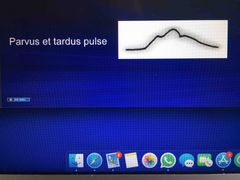![]()
![]()
![]()
Use LEFT and RIGHT arrow keys to navigate between flashcards;
Use UP and DOWN arrow keys to flip the card;
H to show hint;
A reads text to speech;
16 Cards in this Set
- Front
- Back
|
Mortality in AS |
• sudden cardiac death 3-5% • adults mortality rate/year 9% • once symptoms developed sudden death 15-20% (<5y average survival) • exertional angina or syncope present survival is 3y • after LVF bit more than 1y life |
|
|
Classic triad of symptoms |
- chest pain - HF - syncope |
|
|
Typical symptoms of AS |
- palpitation - fatigue - visual disturbances - angina pectoris 30-40% (can develop nitroglicerin indused syncope) - gradual decrease in physical activity with insidious progression of fatigue and dyspnea on exertion - syncope during exertion - syptoms of LVF due to the elevation of the pulmonary capillary pressure from LV dilatation and reduced compliance |
|
|
Symptoms of LVF |
- dyspnea on exertion - nocturnal cough - orthopnea - paroxysmal nocturnal dyspnea - hemoptysis |
|
|
Physical findings in AS |
- systolic thrill may be palpable at the base - crescendo/decrescendo systolic murmur (rough, low-pitched sound, loudest in the base) - ejection click is possible - S4 shows LVH - S3 after the LV dilated and failed - Pulsus parvus et tardus - hight-pitched diastolic blowing murmur in association of AR |
|
|
Pulsus parvus et tardus |
An arterial pulse with delayed and plateaued peak, decreased amplitude and gradual downslope |
|

Front (Term) |

Back (Definition) |
|
|
Causes of AS |
- Congenital AS can be unicuspid or bicuspid, usually asymptomatic - RF - Degenerative calcification for patients older than 70y. Congenital bicuspid valves cause calcific AS 4 times more frequently than acquired forms do |
|
|
Rheumatic fever in AS |
These patients have a fibrous contracture with shortening of the cusps due to recurrent inflammation from rheumatic carditis. Adjacent cusps tend to fuse at the commissures. Calcifications may develop but the primary cause of stenosis is the adhesion that fuse the cusps. |
|
|
Chest radiography in AS |
Cardiac enlargement Mild: minimal enl. Signs of concentric hypertrophy without dilatation, mildly enl. heart rounding at the cardiac apex and slightly backward displacement Severe: signs of LA enl., pulmonary artery enl., right-sided enl., pulmonary congestion |
|
|
ECHO in AS |
- no casp motion is indicative of severe AS - decrease in the maximal aortic cusp separation (<8mm in adult) is also for severe AS - presence of unexplained LVH inplies significant AS |
|
|
ECG in AS |
- 25% without ECG finding - LVH with or without strain pattern - 13% of conduction defect - LA enl. suggests an associated MVP |
|
|
Diferential diagnosis of AS |
- Ventricular septal defect - TR - PS - Hypertrophic obstructive cardiomyopathy - MR |
|
|
Diagnostic studies in ED of AS |
- ECG - X-ray - serum electrolyte level - cardiac enzyme level - arterial blood gas if hypoxemia or mixed respiratory disease state is suspected |
|
|
Treatment of AS |
- Emergent surgery in case of HF due to AS - nitrates/oxygen/morphine for angina pectoris (take care for nitrate induced syncope) - vasodilators - only judiciously - conversion in AFib |
|
|
Surgical therapy in AS |
- prompt valve replacement (symptomatic severe AS) - advise of valve replacement (asymptomatic AS with LVH) If gradient > 80mmHg or valve area < 0.7 cm2 - mechanical prothesis (risk of thromboembolism) - tissue prothesis - bypass |

